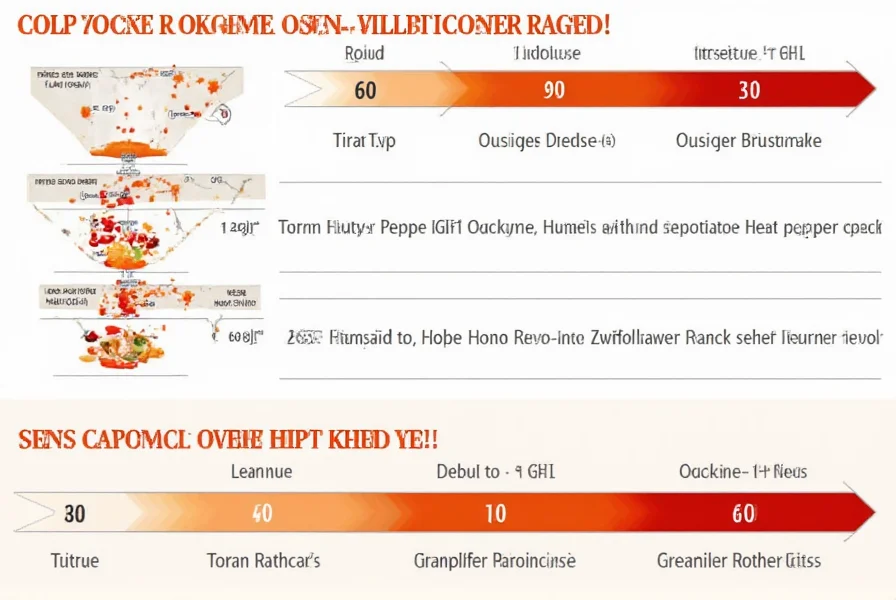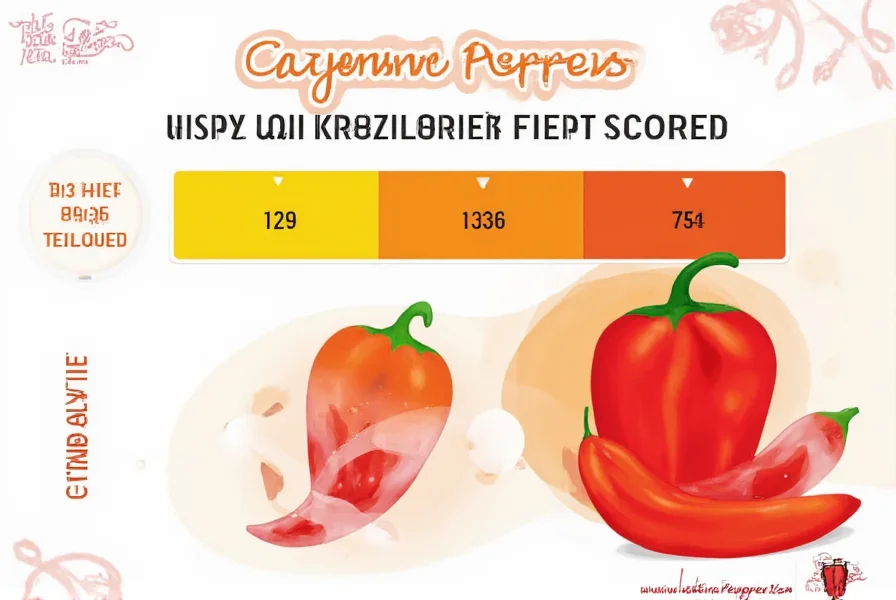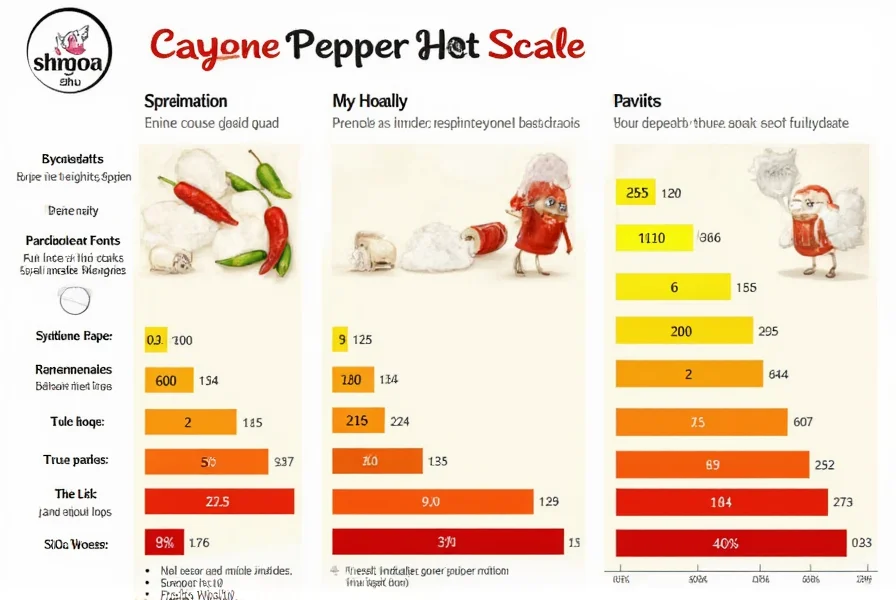Understanding where cayenne pepper falls on the heat scale helps home cooks and culinary professionals use this versatile spice effectively. The Scoville scale, developed by pharmacist Wilbur Scoville in 1912, remains the standard measurement for chili pepper pungency, though modern high-performance liquid chromatography (HPLC) provides more precise readings today.
Understanding the Scoville Heat Scale
The Scoville scale measures capsaicin concentration—the compound responsible for chili heat—in Scoville Heat Units (SHU). Originally determined through human taste panels diluting pepper extract until heat becomes undetectable, the scale has evolved to use scientific measurement while maintaining the same unit system.
Modern laboratories use HPLC to quantify capsaicinoids, then convert these measurements to Scoville units using a standardized formula. This provides consistent, objective heat ratings unaffected by human taste variation. When examining cayenne pepper heat scale information, remember that natural variation occurs within the same pepper variety due to soil conditions, climate, and cultivation practices.
Cayenne Pepper's Specific Heat Range
Cayenne pepper (Capsicum annuum) typically registers between 30,000-50,000 SHU on the Scoville scale. This places it firmly in the medium-hot category, though some varieties can reach up to 75,000 SHU under optimal growing conditions. The heat primarily concentrates in the pepper's placental ribs and seeds, with the flesh containing significantly less capsaicin.
When comparing cayenne pepper scoville units range to other common chilies, it's approximately 12-20 times hotter than a standard jalapeño (2,500-8,000 SHU) but considerably milder than habaneros (100,000-350,000 SHU). This makes cayenne an excellent choice for adding noticeable heat without overwhelming other flavors—a key consideration for those exploring cayenne pepper heat level for cooking.
| Pepper Variety | Scoville Heat Units (SHU) | Heat Comparison to Cayenne |
|---|---|---|
| Bell Pepper | 0 SHU | Not spicy |
| Jalapeño | 2,500-8,000 SHU | 4-12x milder than cayenne |
| Cayenne | 30,000-50,000 SHU | Baseline |
| Thai Bird's Eye | 50,000-100,000 SHU | Slightly to moderately hotter |
| Habanero | 100,000-350,000 SHU | 2-7x hotter than cayenne |

Practical Cooking Implications
Understanding the cayenne pepper heat measurement helps determine appropriate usage in recipes. When substituting fresh cayenne for dried powder, remember that dehydration concentrates capsaicin—typically requiring only 1/3 to 1/2 the amount of dried spice compared to fresh.
For those sensitive to heat, removing seeds and white membranes reduces spiciness significantly while preserving flavor. When exploring how hot is cayenne compared to jalapeno, consider that one small cayenne pepper often equals 4-6 jalapeños in heat intensity. This knowledge proves invaluable when adjusting recipes for different palates.
Culinary professionals often bloom cayenne in oil to distribute heat evenly throughout dishes, while home cooks should add it gradually, tasting as they go. The cayenne pepper spiciness compared to other peppers makes it ideal for Cajun cuisine, hot sauces, and spice blends where noticeable but manageable heat is desired.
Factors Affecting Cayenne's Heat Level
Several elements influence where a specific cayenne pepper falls within its 30,000-50,000 SHU range:
- Water stress: Peppers grown with less water typically develop higher capsaicin levels as a defense mechanism
- Sun exposure: Increased sunlight generally correlates with greater heat production
- Soil composition: Nutrient-rich soils may produce larger but milder peppers
- Ripeness: Fully mature red cayennes tend to be hotter than green immature ones
- Varietal differences: Some cultivated varieties consistently produce higher heat
When examining what is the scoville scale rating for cayenne in commercial products, note that ground cayenne often has more consistent heat than fresh peppers due to blending multiple sources. However, quality can vary significantly between brands—a consideration for serious cooks tracking precise heat levels.

Frequently Asked Questions
How does cayenne pepper compare to red pepper flakes in heat?
Cayenne pepper typically measures 30,000-50,000 SHU, while red pepper flakes (usually made from cayenne and other chilies) range from 15,000-25,000 SHU. The flakes contain varying proportions of seeds and membranes, creating inconsistent heat. One teaspoon of cayenne powder generally equals 1.5-2 teaspoons of red pepper flakes in heat intensity.
Can I substitute cayenne for paprika in recipes?
Yes, but with caution. Standard paprika measures 500-1,000 SHU (sweet) while cayenne is 30,000-50,000 SHU. For hot paprika (5,000-15,000 SHU), use 1/6 to 1/3 the amount of cayenne. When substituting in recipes requiring cayenne pepper heat level for cooking, start with a small amount and adjust to taste, as the heat difference is substantial.
Why does my cayenne pepper taste different from previous batches?
Natural variation in cayenne pepper scoville units range occurs due to growing conditions, harvest time, and processing methods. Commercial blends often mix peppers from different sources, creating batch variations. Store-bought ground cayenne may also lose potency over time—properly stored in an airtight container away from light, it maintains peak heat for 6-12 months.
How can I reduce the heat of cayenne in a dish that's too spicy?
Add dairy products (milk, yogurt, cheese), acidic components (lemon juice, vinegar), or sweeteners (sugar, honey) to counteract capsaicin. Increasing the recipe's volume with additional non-spicy ingredients also dilutes the heat. Remember that cayenne's heat won't diminish with cooking time—unlike some other flavor compounds, capsaicin remains stable when heated.
Is cayenne pepper hotter than sriracha?
Pure cayenne pepper (30,000-50,000 SHU) is significantly hotter than most sriracha sauces (1,000-2,200 SHU). Sriracha typically uses red jalapeños and sometimes includes milder chilies, creating a much more approachable heat. When comparing cayenne pepper spiciness compared to other peppers in sauce form, remember that commercial hot sauces dilute the pure pepper heat with vinegar, garlic, and other ingredients.











 浙公网安备
33010002000092号
浙公网安备
33010002000092号 浙B2-20120091-4
浙B2-20120091-4